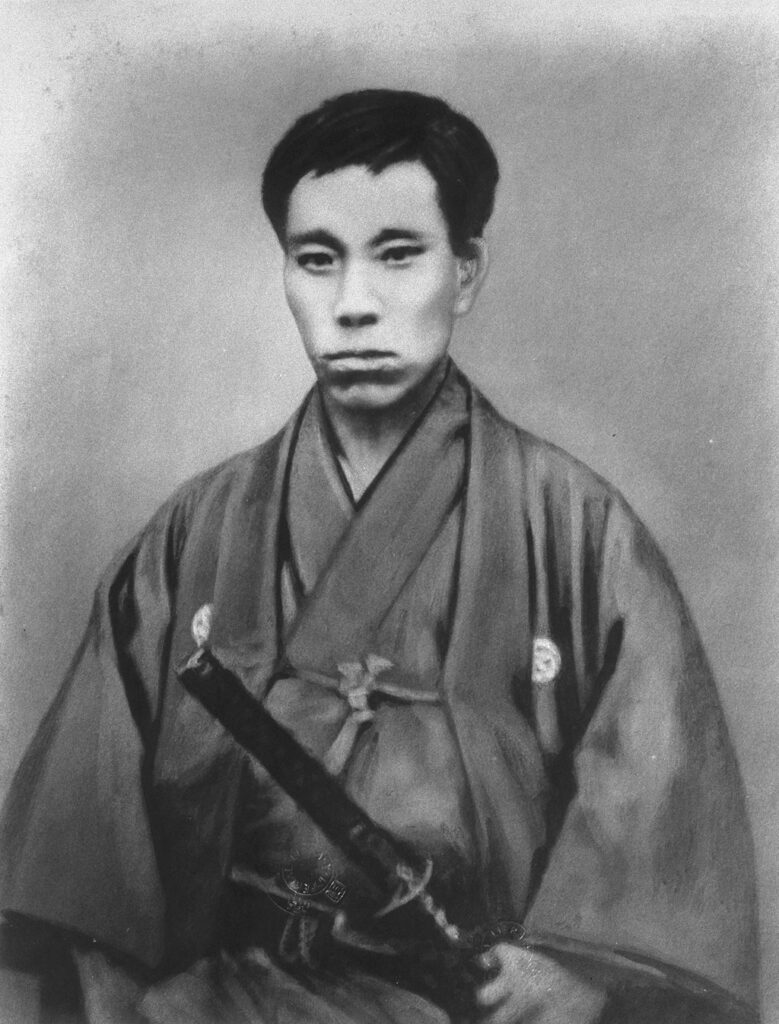

1839 – 1867
高杉晋作
Shinsaku Takasugi
The Visionary Leader of Choshu-Han Who Defied Social Status to Protect Japan
Birth of a Future Leader
Shinsaku Takasugi was born in 1839 in Choshu (modern-day Yamaguchi Prefecture), into a family that had long served the local feudal lord. Demonstrating remarkable intelligence from an early age, Takasugi dedicated himself to martial arts, laying the foundation for his future as a military and political leader.
Entering Shoka Sonjuku
At the age of 19, Takasugi was invited by his childhood friend, Genzui Kusaka, to join Shoka Sonjuku, a private school founded by Shoin Yoshida, a prominent intellectual and reformist who had failed to leave Japan on a black (foreign) ship. Initially, Takasugi struggled with the curriculum due to his resistance to authority, but Yoshida recognized his competitive spirit and encouraged him to rival his peers. Under Yoshida’s mentorship, Takasugi made rapid progress, absorbing both intellectual and ideological lessons that would shape his future path.
The Death of His Teacher
Shoin’s outspoken criticism of the Tokugawa shogunate eventually led to his arrest. In a bid to overthrow the shogunate, Shoin attempted an assassination plot, which was discovered, resulting in his execution. This event had a profound impact on Takasugi, deepening his resolve to challenge the Tokugawa regime and strengthen Japan.
Witnessing Foreign Domination: The Shanghai Incident
At 24, Takasugi traveled to Shanghai, China, where he witnessed the humiliation of the Chinese people by foreign powers, particularly the British, in the wake of their victory in the Opium War. Witnessing the exploitation of a proud culture fueled Takasugi’s growing conviction that Japan needed to reform in order to resist similar foreign domination. Upon returning to Japan, he became a vocal advocate for a stronger, more unified nation. In 1862, he infamously set fire to the British legation in Shinagawa, and though he had initially planned to assassinate high-ranking Tokugawa officials, the scheme was abandoned due to a lack of support.
Formation of the Kiheitai
Takasugi’s political and military vision took shape as he sought to modernize Choshu-Han. After briefly retreating from the public eye to live as a monk, Takasugi returned to the forefront, helping to form the Kiheitai, a military unit that defied the rigid social hierarchy by recruiting men of all classes. The Kiheitai played a crucial role in defending Choshu against both domestic and foreign threats, and its formation marked a decisive shift in Takasugi’s focus from theoretical opposition to practical action.
Political Influence and the Choshu Domain
Takasugi’s involvement in Choshu’s political affairs deepened as tensions escalated in Kyoto. Anti-foreign factions, including some Choshu representatives, were expelled from the Imperial Court, leading to widespread unrest. Takasugi was sent to Kyoto to quell the riots, but due to a misunderstanding, he was arrested and falsely accused of deserting Choshu. While imprisoned, many of his comrades, including Kusaka, died in battle.
In retaliation for Choshu’s attacks on foreign ships, a coalition of British, American, French, and Dutch forces launched a punitive expedition. Takasugi was released from prison to lead peace negotiations with the British. His diplomatic efforts successfully persuaded the shogunate to pay reparations, thereby easing tensions with foreign powers and improving Japan’s standing on the international stage.
Battle with the Shogunate
As Choshu-Han increasingly opposed the Tokugawa shogunate, internal divisions arose between those advocating for submission and those pushing for revolution. Takasugi, a staunch supporter of overthrowing the shogunate, raised an army to confront those within Choshu seeking accommodation with the government. Despite the odds, he emerged victorious and continued to advance the modernization of Choshu’s military, importing Western technology and weapons. This facade of loyalty to the shogunate allowed Choshu to buy time while strengthening its forces.
Illness and Final Days
In 1867, as Choshu formed an alliance with its rival, Satsuma, Takasugi’s health began to deteriorate. Despite contracting tuberculosis, he continued to fight in the defense of Kyushu. By the latter half of the war, however, he was too ill to stand and was forced to withdraw from active duty.
During his final days in Shimonoseki, Takasugi composed a poignant poem: “Omoshiroki koto mo naki yo ni omoshiroku” (Making an uninteresting world interesting). His friend Boto Nomura, who had provided shelter during his exile, added the words: “Suminasu mono wa kokoro narikeri” (It’s all in the mind), a reflection on how one’s outlook shapes the world around them.
Takasugi died at the age of 27, a victim of tuberculosis, leaving behind a legacy of revolutionary ideas and actions.
Personal Life and Interests
Takasugi was known for his love of food, particularly sea bream, which he enjoyed in various forms such as salt soup and sushi, a specialty of his hometown. He also had a fondness for tuna sashimi and was known to have adhered to his mentor Shoin Yoshida’s prohibition against eating fugu (pufferfish), due to its toxicity.
In addition to his political and military endeavors, Takasugi was an avid musician and poet. He frequently carried a folding shamisen and composed songs, one of which, “Sanzen sekai no karasu wo koroshi, aruji to asane ga shite mitai,” (Kill the crows of the world, I want to play with my master), remains a testament to his creative spirit.
Takasugi’s short life was marked by turbulence and contradiction: he was a revolutionary leader, a poet, and a lover of simple pleasures. Though his life ended prematurely, his influence on Japan’s modernization and his vision for a stronger, more independent nation continue to be remembered today.
.
.
.



